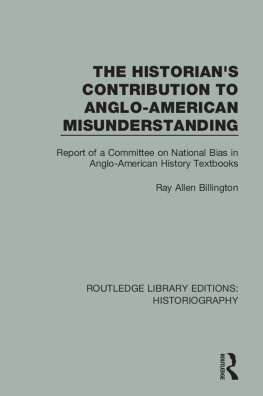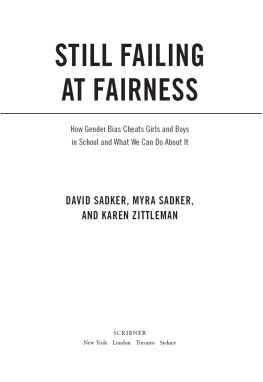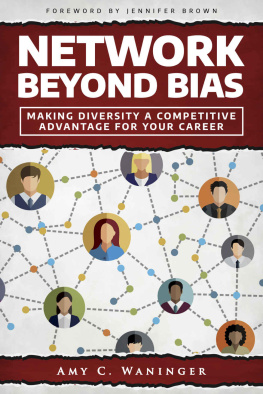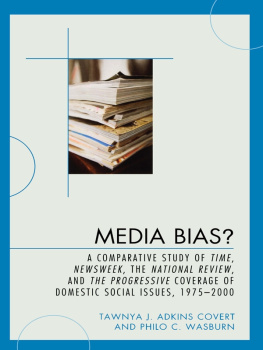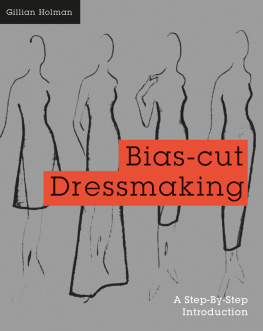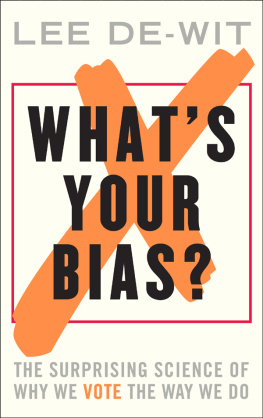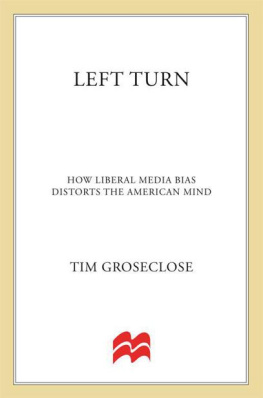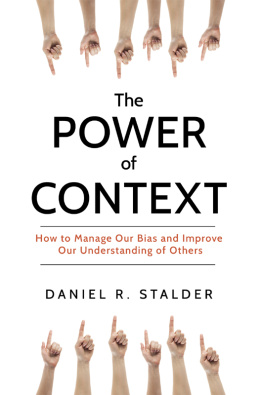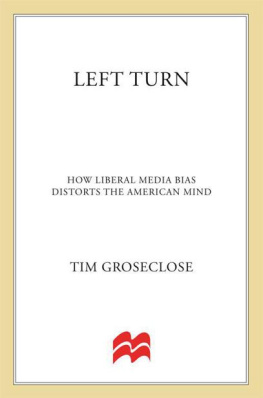ROUTLEDGE LIBRARY EDITIONS: HISTORIOGRAPHY
Volume 3
THE HISTORIANS CONTRIBUTION TO ANGLO-AMERICAN MISUNDERSTANDING
THE HISTORIANS CONTRIBUTION TO ANGLO-AMERICAN MISUNDERSTANDING
Report of a Committee on National Bias in Anglo-American History Textbooks
RAY ALLEN BILLINGTON
With the collaboration of
C. P. HILL, ANGUS J. JOHNSTON II, C. L. MOWAT AND CHARLES F. MULLETT
First published in 1966 by Routledge & Kegan Paul Limited
This edition first published in 2016
by Routledge
2 Park Square, Milton Park, Abingdon, Oxon OX14 4RN
and by Routledge
711 Third Avenue, New York, NY 10017
Routledge is an imprint of the Taylor & Francis Group, an informa business
1966 Ray Allen Billington
All rights reserved. No part of this book may be reprinted or reproduced or utilised in any form or by any electronic, mechanical, or other means, now known or hereafter invented, including photocopying and recording, or in any information storage or retrieval system, without permission in writing from the publishers.
Trademark notice: Product or corporate names may be trademarks or registered trademarks, and are used only for identification and explanation without intent to infringe.
British Library Cataloguing in Publication Data
A catalogue record for this book is available from the British Library
ISBN: 978-1-138-99958-9 (Set)
ISBN: 978-1-315-63745-7 (Set) (ebk)
ISBN: 978-1-138-19476-2 (Volume 3) (hbk)
ISBN: 978-1-315-63868-3 (Volume 3) (ebk)
Publishers Note
The publisher has gone to great lengths to ensure the quality of this reprint but points out that some imperfections in the original copies may be apparent.
Disclaimer
The publisher has made every effort to trace copyright holders and would welcome correspondence from those they have been unable to trace.
THE HISTORIANS CONTRIBUTION TO ANGLO-AMERICAN MISUNDERSTANDING
Report of a Committee on National Bias in Anglo-American History Textbooks
by
RAY ALLEN BILLINGTON
With the collaboration of
C. P. HILL, ANGUS J. JOHNSTON II, C. L. MOWAT and CHARLES F. MULLETT
First published in 1966
by Routledge & Kegan Paul Limited
Broadway House, 68-74 Carter Lane
London, E.C.4
Printed in Great Britain
by C. Tinling & Co. Limited
Liverpool, London and Prescot
Ray Allen Billington 1966
No part of this book may be reproduced
in any form without permission from
the publisher, except for the quotation
of brief passages in criticism
CONTENTS
ILLUSTRATIONS
.
.
.
.
.
.
.
.
.
.
.
T HIS book can trace its origins to a seminar on Perspectives on the American Revolutionary Era which in the autumn of 1960 brought together at Colonial Williamsburg a group of scholars from England, the United States, and Canada. Two of those scholars, Professor Harry C. Allen of University College, University of London, and Professor Richard P. McCormick of Rutgers University, fell to discussing national bias in the secondary school textbooks of their respective nations. This casual conversation, as often happens, was destined to mushroom into a full-scale investigation, complete with professional and foundation support, and conducted by a hierarchy of committees.
The first step was to secure the backing of the three professional associations most concerned: the Historical Association of England and Wales, the British Association for American Studies, and the American Historical Association. Dr. Boyd Shafer, executive secretary of the latter society, was first approached, and gave the project his enthusiastic support. Under his guidance a detailed plan was prepared for submission to the three associations during the winter of 19601961. In November the Historical Association of England and Wales endorsed this plan; the council of the American Historical Association took similar action in December. The officials of these societies, together with those of the British Association for American Studies, undertook the additional responsibility of soliciting funds necessary to conduct the investigation. These were obtained in the spring of 1962 through the generosity of the Nuffield Trust of England and the Ford Foundation of the United States.
Next came the drafting of the usual committees. A Sponsoring Committee was named first, composed of Professor G. R. Potter of the University of Sheffield, Professor Reginald F. Treharne of the University College of Wales, Aberystwyth, and Mr. E. H. Dance of Wolverhampton representing the Historical Association of England and Wales; Professor Harry C. Allen of University College, London, representing the British Association for American Studies; and Professors Caroline Robbins of Bryn Mawr College, Richard P. McCormick of Rutgers University, and Ray A. Billington of Northwestern University, representing the American Historical Association. This committee defined the principal lines of inquiry and established the methods that would be used in textbook analysis.
Its principal task was to select a Working Party that would carry on the investigation and prepare a publishable report. This was named during the autumn of 1962: Professor C. L. Mowat of the University College of North Wales, Bangor, Mr. C. P. Hill of the Department of Education, University of Exeter, Dr. Angus J. Johnston II of the Social Studies Department, New Trier High School, Winnetka, Illinois, and Dr. Ray A. Billington, now of the Henry E. Huntington Library, chairman. Dr. Boyd C. Shafer of the American Historical Association and Professor Richard P. McCormick of Rutgers University agreed to co-operate closely with the Working Party.
Procedures were then agreed upon. Two possible methods of textbook analysis could be employed. One would encourage each member of the Working Party to read widely and with little guidance, isolating instances of nationalistic bias whenever detected. The other would direct the analysis to specific historical episodes which seemed especially susceptible to biased treatment, with each member of the Working Party following agreed-upon techniques in identifying these instances. The latter method seemed to promise better results. It would allow analysis in depth, and would highlight the contrasting views of national bias held by British and American analysts. Hence the Planning Committee agreed that the Working Party should concentrate on three episodes: (1) the American Revolution, (2) the War of 1812, and (3) the First World War. It was also agreed that members of the Working Party should define nationalistic bias in terms suggested by Mr. E. H. Dance in a helpful memorandum prepared for the committee, and in that same authors study of the subject: History the Betrayer: a Studyof Bias (Hutchinson, London, 1960). A bibliography prepared by Mr. Dance also allowed members of the Working Party to sample representative modern works dealing with national bias in historical studies.
The next step was to select textbooks for analysis. Thanks largely to the help of a member of the Working Party, Mr. C. P. Hill, himself a textbook author of note well acquainted with the English educational system, the choosing of English books presented no great problem; Mr. Hill after consultation with other teachers provided the committee with a list of books most widely used in both Grammar Schools and Secondary Modern Schools at the 12 to 16 age level. Selection of the textbooks most popular in American Junior High Schools and High Schools proved more difficult; publishers were unwilling to reveal sales statistics while state adoption lists varied too widely to be useful. Eventually the Working Party sought the advice of three experts in the field of secondary school history teaching: Professors Erling Hunt of Columbia University, William H. Cartwright of Duke University, and Richard E. Gross of Stanford University. Each generously supplied a list of textbooks that he considered most popular; insomuch as these lists agreed in almost every detail it was possible to distil from them a selection of the textbooks that provide nearly all of the instruction in American history in Junior and Senior High Schools in the United States.

